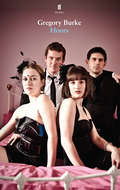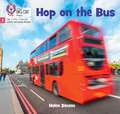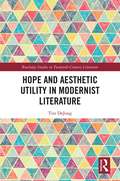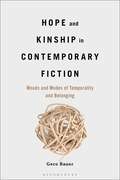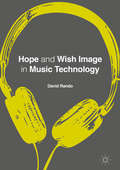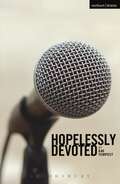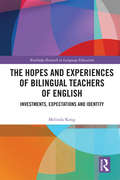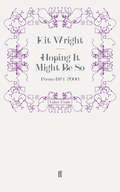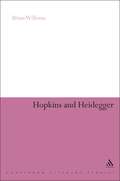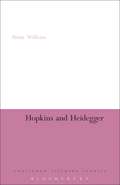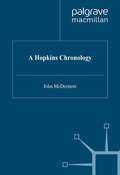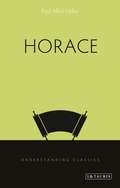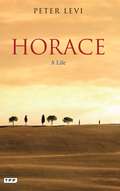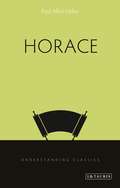- Table View
- List View
Hooked: Art and Attachment
by Rita FelskiHow does a novel entice or enlist us? How does a song surprise or seduce us? Why do we bristle when a friend belittles a book we love, or fall into a funk when a favored TV series comes to an end? What characterizes the aesthetic experiences of feeling captivated by works of art? In Hooked, Rita Felski challenges the ethos of critical aloofness that is a part of modern intellectuals’ self-image. The result is sure to be as widely read as Felski’s book, The Limits of Critique. Wresting the language of affinity away from accusations of sticky sentiment and manipulative marketing, Felski argues that “being hooked” is as fundamental to the appreciation of high art as to the enjoyment of popular culture. Hooked zeroes in on three attachment devices that connect audiences to works of art: identification, attunement, and interpretation. Drawing on examples from literature, film, music, and painting—from Joni Mitchell to Matisse, from Thomas Bernhard to Thelma and Louise—Felski brings the language of attachment into the academy. Hooked returns us to the fundamentals of aesthetic experience, showing that the social meanings of artworks are generated not just by critics, but also by the responses of captivated audiences.
Hooked: Art and Attachment
by Rita FelskiHow does a novel entice or enlist us? How does a song surprise or seduce us? Why do we bristle when a friend belittles a book we love, or fall into a funk when a favored TV series comes to an end? What characterizes the aesthetic experiences of feeling captivated by works of art? In Hooked, Rita Felski challenges the ethos of critical aloofness that is a part of modern intellectuals’ self-image. The result is sure to be as widely read as Felski’s book, The Limits of Critique. Wresting the language of affinity away from accusations of sticky sentiment and manipulative marketing, Felski argues that “being hooked” is as fundamental to the appreciation of high art as to the enjoyment of popular culture. Hooked zeroes in on three attachment devices that connect audiences to works of art: identification, attunement, and interpretation. Drawing on examples from literature, film, music, and painting—from Joni Mitchell to Matisse, from Thomas Bernhard to Thelma and Louise—Felski brings the language of attachment into the academy. Hooked returns us to the fundamentals of aesthetic experience, showing that the social meanings of artworks are generated not just by critics, but also by the responses of captivated audiences.
Hooking Up
by Tom WolfeIn Hooking Up Tom Wolfe ranges from coast to coast, observing the 'lurid carnival actually taking place in the mightiest country on earth in the year 2000' - everything from teenage sexual manners to how genetics and neuroscience are changing the way we regard ourselves. Also included in this collection are some of his most classic and enduring pieces of journalism, and 'Ambush art at Fort Bragg', his fiercely satirical novella about sting TV.Funny, often savagely so, hard-hitting and wise, Wolfe remains a unique master-chronicler of America and its future.
Hoors
by Gregory BurkeSmall Town, Fife. Andy and Vicky were meant to be getting married tomorrow.The trouble is, Andy's stag weekend was so epic, so legendary, that he didn't survive it. The finest pleasures that Amsterdam and Hamburg have to offer, together with a mile-high fling with a budget-airline stewardess, brought him down to earth with a bump. Now it's time for the post-mortem. A black comedy about waking up to find the party's over, Gregory Burke's Hoors premiered at the Traverse Theatre, Edinburgh, in May 2009.
Hop On The Bus: Phase 2 Set 4 (Big Cat Phonics For Little Wandle Letters And Sounds Revised Ser.)
by Helen Dineen Collins Big CatHope and Aesthetic Utility in Modernist Literature (Routledge Studies in Twentieth-Century Literature)
by Tim DeJong"Hope" and "modernism" are two words that are not commonly linked. Moving from much-discussed negative affects to positive forms of feeling, Hope and Aesthetic Utility in Modernist Literature argues that they should be. This book contends that much of modernist writing and thought reveals a deeply held confidence about the future, one premised on the social power of art itself. In chapters ranging across a diverse array of canonical writers – Henry James, D.W. Griffith, H.D., Melvin Tolson, and Samuel Beckett – this text locates in their works an optimism linked by a common faith in the necessity of artistic practice for cultural survival. In this way, the famously self-attentive nature of modernism becomes a means, for its central thinkers and artists, of reflecting on what DeJong calls aesthetic utility: the unpredictable, ungovernable capacity of the work of art to shape the future even while envisioning it.
Hope and Aesthetic Utility in Modernist Literature (Routledge Studies in Twentieth-Century Literature)
by Tim DeJong"Hope" and "modernism" are two words that are not commonly linked. Moving from much-discussed negative affects to positive forms of feeling, Hope and Aesthetic Utility in Modernist Literature argues that they should be. This book contends that much of modernist writing and thought reveals a deeply held confidence about the future, one premised on the social power of art itself. In chapters ranging across a diverse array of canonical writers – Henry James, D.W. Griffith, H.D., Melvin Tolson, and Samuel Beckett – this text locates in their works an optimism linked by a common faith in the necessity of artistic practice for cultural survival. In this way, the famously self-attentive nature of modernism becomes a means, for its central thinkers and artists, of reflecting on what DeJong calls aesthetic utility: the unpredictable, ungovernable capacity of the work of art to shape the future even while envisioning it.
Hope and Honor: Jewish Resistance during the Holocaust
by Rachel L. EinwohnerA powerful account of Jewish resistence in Nazi-occupied Europe and why such resistance was so remarkable. Most popular accounts of the Holocaust typically cast Jewish victims as meek and ask, "Why didn't Jews resist?" But we know now that Jews did resist, staging armed uprisings in ghettos and camps throughout Nazi-occupied Europe. In Hope and Honor, Rachel L. Einwohner illustrates the dangers in attempting resistance under unimaginable conditions and shows how remarkable such resistance was. She draws on oral testimonies, published and unpublished diaries and memoirs, and other written materials produced both by survivors and those who perished to show how Jews living under Nazi occupation in the ghettos of Warsaw, Vilna, and Lódz reached decisions about resistance. Using methods of comparative-historical sociology, Einwohner shows that decisions about resistance rested on Jews' assessments of the threats facing them, and somewhat ironically, armed resistance took place only once activists reached the critical conclusion that they had no hope for survival. Rather than ask the typical question of why Jews generally didn't resist, this powerful account of Jewish resistance seeks to explain why they resisted at all when there was no hope for success, and they faced almost certain death.
Hope and Honor: Jewish Resistance during the Holocaust
by Rachel L. EinwohnerA powerful account of Jewish resistence in Nazi-occupied Europe and why such resistance was so remarkable. Most popular accounts of the Holocaust typically cast Jewish victims as meek and ask, "Why didn't Jews resist?" But we know now that Jews did resist, staging armed uprisings in ghettos and camps throughout Nazi-occupied Europe. In Hope and Honor, Rachel L. Einwohner illustrates the dangers in attempting resistance under unimaginable conditions and shows how remarkable such resistance was. She draws on oral testimonies, published and unpublished diaries and memoirs, and other written materials produced both by survivors and those who perished to show how Jews living under Nazi occupation in the ghettos of Warsaw, Vilna, and Lódz reached decisions about resistance. Using methods of comparative-historical sociology, Einwohner shows that decisions about resistance rested on Jews' assessments of the threats facing them, and somewhat ironically, armed resistance took place only once activists reached the critical conclusion that they had no hope for survival. Rather than ask the typical question of why Jews generally didn't resist, this powerful account of Jewish resistance seeks to explain why they resisted at all when there was no hope for success, and they faced almost certain death.
Hope and Kinship in Contemporary Fiction: Moods and Modes of Temporality and Belonging
by Dr. Gero BauerExplores the emphasis that contemporary novels, films and television series place on the present, arguing that hope emerges from the potentiality of the here and now, rather than the future, and as intimately entangled with negotiations of structures of belonging.Taking its cue from an understanding of hope as connoting an organizing temporality, one which is often presumed to be projecting into a future, Hope and Kinship in Contemporary Fiction challenges this understanding, arguing that hope emerges in practices of relationality in the present, disentangling hope from a necessary correlation with futurity. Through close readings of contemporary works, including The Road, The Walking Dead, Cloud Atlas, Sense8, The People in the Trees and A Little Life, Gero Bauer investigates how these texts explore structures of kinship as creative and affective practices of belonging and care that claim spaces beyond the heterosexual, reproductive nuclear family. In this context, fictional figurations of the child – often considered the bearer of the future – are of particular interest. Through these interventions into definitions of and reflections on fictional manifestations of hope and kinship, Bauer's analyses intersect with queer theory, new materialism and postcritical approaches to literature and cultural studies, moving towards counterintuitively hopeful readings of the present moment.
Hope and Kinship in Contemporary Fiction: Moods and Modes of Temporality and Belonging
by Dr. Gero BauerExplores the emphasis that contemporary novels, films and television series place on the present, arguing that hope emerges from the potentiality of the here and now, rather than the future, and as intimately entangled with negotiations of structures of belonging.Taking its cue from an understanding of hope as connoting an organizing temporality, one which is often presumed to be projecting into a future, Hope and Kinship in Contemporary Fiction challenges this understanding, arguing that hope emerges in practices of relationality in the present, disentangling hope from a necessary correlation with futurity. Through close readings of contemporary works, including The Road, The Walking Dead, Cloud Atlas, Sense8, The People in the Trees and A Little Life, Gero Bauer investigates how these texts explore structures of kinship as creative and affective practices of belonging and care that claim spaces beyond the heterosexual, reproductive nuclear family. In this context, fictional figurations of the child – often considered the bearer of the future – are of particular interest. Through these interventions into definitions of and reflections on fictional manifestations of hope and kinship, Bauer's analyses intersect with queer theory, new materialism and postcritical approaches to literature and cultural studies, moving towards counterintuitively hopeful readings of the present moment.
Hope and Wish Image in Music Technology
by David P. RandoThis book proposes that new music technologies attract unconscious desires for socialism and collectivity, enabling millions of people living under capitalism to dream of repressed social alternatives. Grounded in the philosophical writings of Ernst Bloch and Walter Benjamin, the book examines file sharing technologies, streaming services, and media players, as well as their historical antecedents, such as the player piano, cassette tape, radio and compact disc, alongside interpretations of fiction, memoir, and albums. Through the concept of wish images—the unconscious hopes and desires for social alternatives that gather around new technologies—the book identifies the repressed pre- and post-capitalist urges that attend our music technologies. While these desires typically remain unconscious and tend to pass away not only unmet but also unrecognized, Hope and Wish Image in Music Technology attempts to bring wishes for social alternatives to the surface at an auspicious moment of technological transition.
Hope and Wish Image in Music Technology (PDF)
by David P. RandoThis book proposes that new music technologies attract unconscious desires for socialism and collectivity, enabling millions of people living under capitalism to dream of repressed social alternatives. Grounded in the philosophical writings of Ernst Bloch and Walter Benjamin, the book examines file sharing technologies, streaming services, and media players, as well as their historical antecedents, such as the player piano, cassette tape, radio and compact disc, alongside interpretations of fiction, memoir, and albums. Through the concept of wish images—the unconscious hopes and desires for social alternatives that gather around new technologies—the book identifies the repressed pre- and post-capitalist urges that attend our music technologies. While these desires typically remain unconscious and tend to pass away not only unmet but also unrecognized, Hope and Wish Image in Music Technology attempts to bring wishes for social alternatives to the surface at an auspicious moment of technological transition.
Hopelessly Devoted (Modern Plays)
by Kate TempestFreedom has only ever meant Love. And life lived without loveIs not life enough. Chess is in prison. Facing a lengthy sentence, her cell mate, Serena, becomes her soul mate. But when Serena is given parole, Chess faces total isolation.Hope comes in the form of a music producer looking for a reason to love music again. She finds a powerful voice in Chess. But to harness her talent, Chess must first face her past. Featuring Kate Tempest's trademark lyrical fireworks and live music, this is a story of love and redemption. Hopelessly Devoted received its world premiere on 19 September 2013 at the DOOR, Birmingham Rep, co-produced by Paines Plough and Birmingham Rep. It toured the UK again in 2014.
Hopelessly Devoted (Modern Plays)
by Kate TempestFreedom has only ever meant Love. And life lived without loveIs not life enough. Chess is in prison. Facing a lengthy sentence, her cell mate, Serena, becomes her soul mate. But when Serena is given parole, Chess faces total isolation.Hope comes in the form of a music producer looking for a reason to love music again. She finds a powerful voice in Chess. But to harness her talent, Chess must first face her past. Featuring Kate Tempest's trademark lyrical fireworks and live music, this is a story of love and redemption. Hopelessly Devoted received its world premiere on 19 September 2013 at the DOOR, Birmingham Rep, co-produced by Paines Plough and Birmingham Rep. It toured the UK again in 2014.
The Hopes and Experiences of Bilingual Teachers of English: Investments, Expectations and Identity (Routledge Research in Language Education)
by Melinda KongIn this age of internationalisation of higher education, many bilingual teachers from non-English-speaking contexts pursue their postgraduate degrees in English-speaking countries. Most programmes focus on providing content knowledge to them, while neglecting their investments. Furthermore, not much attention is given to what these bilingual teachers expect to gain from studying abroad, as well as their lived experiences and identity construction both inside and outside the classroom in English-speaking countries and when they return home. Nevertheless, these dimensions are crucial to their growth as teachers and users of English. This book explores these neglected aspects through case studies of bilinguals from various backgrounds. Through these case studies, the book examines the hopes, struggles and adaptation of bilinguals. It provides insights into what international students should realistically expect when studying overseas, and how to empower bilingual teachers, users and learners of English.
The Hopes and Experiences of Bilingual Teachers of English: Investments, Expectations and Identity (Routledge Research in Language Education)
by Melinda KongIn this age of internationalisation of higher education, many bilingual teachers from non-English-speaking contexts pursue their postgraduate degrees in English-speaking countries. Most programmes focus on providing content knowledge to them, while neglecting their investments. Furthermore, not much attention is given to what these bilingual teachers expect to gain from studying abroad, as well as their lived experiences and identity construction both inside and outside the classroom in English-speaking countries and when they return home. Nevertheless, these dimensions are crucial to their growth as teachers and users of English. This book explores these neglected aspects through case studies of bilinguals from various backgrounds. Through these case studies, the book examines the hopes, struggles and adaptation of bilinguals. It provides insights into what international students should realistically expect when studying overseas, and how to empower bilingual teachers, users and learners of English.
Hoping It Might Be So: Poems 1974-2000
by Kit WrightHoping It Might Be So brings together all of Kit Wright's previous collections for adults as well as three dozen new poems. The collection, first published in 2000, was described by Christina Patterson in the Sunday Times as 'funny and profoundly humane' and by Sophie Hannah in the PN Review as 'full of verve and energy, with a strong musical quality that makes you want to read on and hear more'. Sean O'Brien in the Times Literary Supplement described Kit Wright as 'a masterly yet modest poet' while Ruth Padel in the Independent on Sunday said that 'all through his work there is that poignancy, darkness, brush with despair, which marks great comic work.' The poet Anthony Wilson said that Wright 'can be funny, serious and moving, and sometimes all three in the space of a single poem'.Hoping It Might Be So is a rewarding collection from an interesting, prolific and lively poet whose poems range from ribald to grief-stricken, elegiac to rambunctious
Hopkins and Heidegger (Continuum Literary Studies)
by Brian WillemsHopkins and Heidegger is a new exploration of Gerard Manley Hopkins' poetics through the work of Martin Heidegger. More radically, Brian Willems argues that the work of Hopkins does no less than propose solutions to a number of hitherto unresolved questions regarding Heidegger's later writings, vitalizing the concepts of both writers beyond their local contexts. Willems examines a number of cross-sections between the poetry and thought of Hopkins and the philosophy of Heidegger. While neither writer ever directly addressed the other's work - Hopkins died the year Heidegger was born, 1899, and Heidegger never turns his thoughts on poetry to the Victorians - a number of similarities between the two have been noted but never fleshed out. Willems' readings of these cross-sections are centred on Hopkins' concepts of 'inscape' and 'instress' and around Heidegger's reading of both appropriation (Ereignis) and the fourfold (das Geviert). This study will be of interest to scholars and postgraduates in both Victorian literature and Continental philosophy.
Hopkins and Heidegger (Continuum Literary Studies #191)
by Brian WillemsHopkins and Heidegger is a new exploration of Gerard Manley Hopkins' poetics through the work of Martin Heidegger. More radically, Brian Willems argues that the work of Hopkins does no less than propose solutions to a number of hitherto unresolved questions regarding Heidegger's later writings, vitalizing the concepts of both writers beyond their local contexts. Willems examines a number of cross-sections between the poetry and thought of Hopkins and the philosophy of Heidegger. While neither writer ever directly addressed the other's work - Hopkins died the year Heidegger was born, 1899, and Heidegger never turns his thoughts on poetry to the Victorians - a number of similarities between the two have been noted but never fleshed out. Willems' readings of these cross-sections are centred on Hopkins' concepts of 'inscape' and 'instress' and around Heidegger's reading of both appropriation (Ereignis) and the fourfold (das Geviert). This study will be of interest to scholars and postgraduates in both Victorian literature and Continental philosophy.
A Hopkins Chronology (Author Chronologies Series)
by J. McDermottThis Hopkins chronology describes the poet's family and early education, then gives a day-by-day account of what he was doing, reading and writing, and the people he met. Drawing on some material not published before, it illustrates the working life of a priest-poet whose work was not made public until more than thirty years after his death. There are additional sections on the religious and political background of a major Victorian writer whose life was essentially enigmatic and private.
Horace (Understanding Classics)
by Paul Allen MillerPerhaps no classical writer has been so consistently in vogue as Horace. Famous in his own lifetime as a close associate of the Emperor Octavian, to whom he dedicated several odes, Quintus Horatius Flaccus (65–8 BC) has never really been out of fashion. Petrarch, for example, modelled his letters on Horace's innovative Epistles, while also borrowing from his Roman forebear in composing his own Italian sonnets. The echo of Horace's voice can be found in almost every genre of medieval literature. And in later periods, this influence and popularity if anything increased. Yet, as Paul Allen Miller shows, while Horace may justifiably be called the poet for all seasons he is also in the end an enigma. His elusive, ironic contrariness is perhaps the true secret of his success. A cultured man of letters, he fought on the losing side of the Battle of Philippi (42 BC). A staunch Republican, he ended up eagerly (some said too eagerly) promoting the cause of Julio-Claudian imperialism. Viewed as the acme of Roman literary civilization, he was shaped by his Athens education at Plato's famous Academy. This new introduction reveals Horace in all his paradoxical genius and complexity.
Horace: A Life
by Peter LeviThe work of the great Roman poet, Horatius Flaccus (65 BC to 8 BC), spanned all aspects of Roman life: politics, the arts, religion, and the authority of the emperor, while his legendary poems (Satires, Odes, Epistles) about friendship, philosophy, love and sex still have widespread appeal. This biography attempts to present a complete picture of Horace's life and world. It considers the details of Horace's romantic liaisons and why he never married, what the status of his father - a freed man - meant to the poet, and his distinctive brand of philosophy. In this acclaimed biography, Peter Levi - a fellow poet - has produced a thrilling and eminently readable book, the definitive on Rome's greatest poet and the times during which he lived.
Horace: Image, Identity, and Audience
by Randall L. McNeillTraditional views of Horace seek to present the poet as a consistent, vivid personality who stands behind and orchestrates the diverse "Horatian" writings that have come down to us. In recent years, however, an alternate tradition suggests that there may be many Horaces, that his work is more productively read as the constant invention of rhetorical techniques sensitively attuned to the requirements of different situations and audiences. As Randall L. B. McNeill argues, any sense that readers have of the "real" Horace is clearly deceptive; Horace offers us no unguarded self-portrait, but rather a number of consciously developed characterizations to suit diverse audiences, whether patron, peers, or the public.Horace: Image, Identity, and Audience provides a wide-ranging analysis of Horace's use of self-presentation in his poetry: in his portrayal of his relationships with his patron Maecenas and with his larger readership as a whole; in his discussion of the craft of poetry and his own identity as a poet; and in his handling of contemporary Roman political events in the light of his assumed role as critic of his own society. McNeill uncovers the techniques Horace uses to depict the intricacies of his personal existence; in the book's conclusion, he explores how similar techniques were adapted by later poets such as Ovid. This volume will interest scholars of Horace, Latin poetry, rhetoric, as well as those interested in the cultural studies aspect of persona and identity.
Horace (Understanding Classics)
by Paul Allen MillerPerhaps no classical writer has been so consistently in vogue as Horace. Famous in his own lifetime as a close associate of the Emperor Octavian, to whom he dedicated several odes, Quintus Horatius Flaccus (65–8 BC) has never really been out of fashion. Petrarch, for example, modelled his letters on Horace's innovative Epistles, while also borrowing from his Roman forebear in composing his own Italian sonnets. The echo of Horace's voice can be found in almost every genre of medieval literature. And in later periods, this influence and popularity if anything increased. Yet, as Paul Allen Miller shows, while Horace may justifiably be called the poet for all seasons he is also in the end an enigma. His elusive, ironic contrariness is perhaps the true secret of his success. A cultured man of letters, he fought on the losing side of the Battle of Philippi (42 BC). A staunch Republican, he ended up eagerly (some said too eagerly) promoting the cause of Julio-Claudian imperialism. Viewed as the acme of Roman literary civilization, he was shaped by his Athens education at Plato's famous Academy. This new introduction reveals Horace in all his paradoxical genius and complexity.



